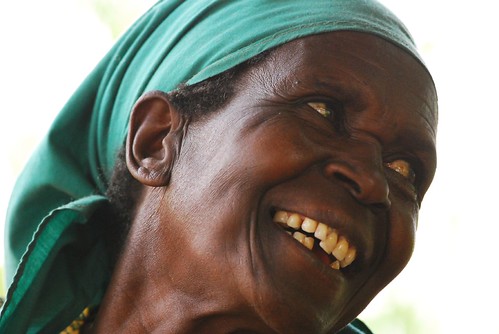
I spent two six week periods in Kenya over the last two summers. A fair amount of my time there was spent working with and watching a woman named Robai and her family make and sell pots. This is that photo narrative:

It was after a short, but furiously-paced walk from Robai's homestead that we witnessed the first step of the potting process. No clay, no pots. Simple as that. Down one of the many red-orange Kenyan roads and to the left there was (what appeared to be) a run-off ditch. I straddled the small crevasse and watched as Robai skillfully dug into the wall and pulled out the grey and gravelly clay.
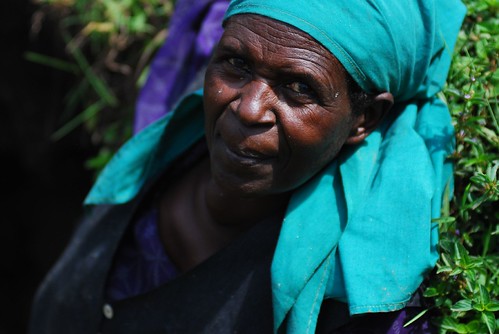
Her face stained with clay, Robai looked up for a moment while she rested. In the next instant she beamed with delight seeing my camera focused on her.
Here, Robai's family works over the clay, first beating it with an overturned hoe and then picking out the finer inclusions. Rocky bits within the clay might cause the pot to shatter while firing.
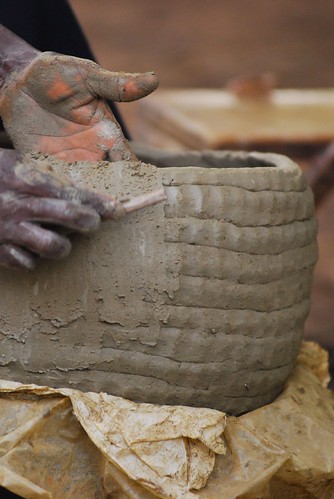
The potters work with rhythmic skill. They mold the clay into long strips and wrap them around a base to produce the shape. The coils are then smoothed with pieces of wood and plastic. When pots shatter during firing or after being buried, they sometimes fracture in ways that show the weaknesses in the coils.
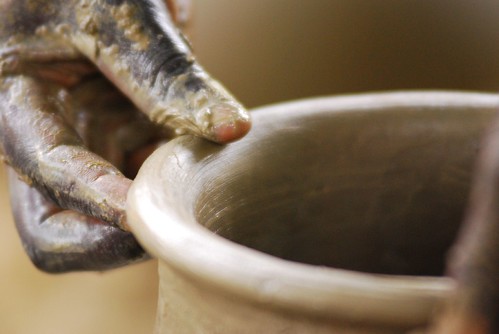
In the shade of Robai's house some 13 of us sat quietly, transfixed by the magic in front of us. With great ease and skill the hands of Robai and her family worked to produce delicate and decorative vessels from the raw clay. Light fell in small patches through the fruit tree where the children played. This soft ambiance created a calm unlike any I've ever felt before. Glowing yellow light bathed the earthy pots. Robai and her co-workers muttered in soft Swahili, foreign to my ears, but nonetheless comforting; it was as if there were no language or cultural barriers.

After the pots dried slowly in Robai's house for over a week, they were to be fired. A large open kiln was constructed from dry wood purchased in town. The floor rests above the ground so that air could feed the heat of the fire. Pots were then stacked atop this floor, covered in the rest of the wood as well as dry grass and then the kiln set alight.
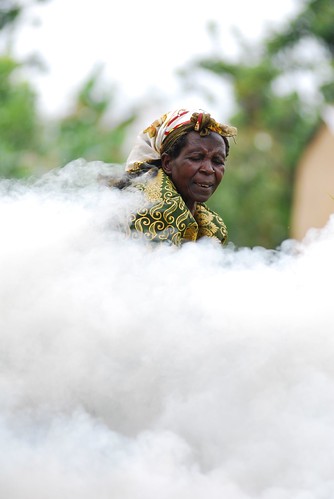
The smoke and heat from this kiln is intense. A cloud rose for tens, if not hundreds, of feet into the sky above. Robai tended carefully to the fire, continually adding more grass. Here she pokes her head above the thick smoke she was walking through.
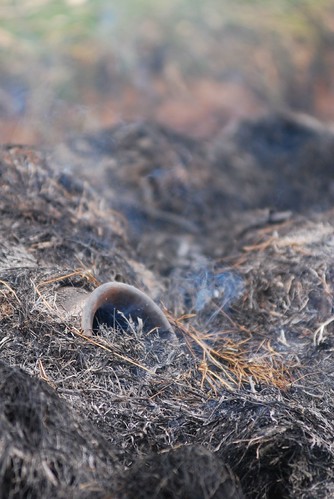
An hour later the fire dies down. The heat still radiates some 20 feet from the kiln. The pots, now fire-hardened peek through from the ash of the grass. Soon they were removed one by one by Robai and her family. In a stroke of luck, all 102 pots that were made from the clay survived the firing process.

A successful firing means dancing and hugs all around. Maybe she was dancing because all the pots made it through. Maybe it was because she had finished a 3 week long process. Maybe it was because she knew she would be paid in full. Regardless, her mood raised the spirits of even the ill anthropologists.

Here, Robai (far right) and her family stand in front of their product. These fine pots were collected by the director of the project. This man loves his pots and, in a moment of unprecedented generosity, he let the students choose two pots to take with them as keepsakes.

The time I spent in the soft and mesmerizing shade of Robai's house is one of the fondest memories I have of Kenya. Surpasing the grand landscapes of the Rift Valley, the archaeological sites and the rural towns, it is the cool, damp soil behind Robai's house that is Kenya for me. It was this process that caused me, for the first time, to put down my camera (thoughts of photos drifting far from my mind) and simply sit and watch and be.

The potters work with rhythmic skill. They mold the clay into long strips and wrap them around a base to produce the shape. The coils are then smoothed with pieces of wood and plastic. When pots shatter during firing or after being buried, they sometimes fracture in ways that show the weaknesses in the coils.

In the shade of Robai's house some 13 of us sat quietly, transfixed by the magic in front of us. With great ease and skill the hands of Robai and her family worked to produce delicate and decorative vessels from the raw clay. Light fell in small patches through the fruit tree where the children played. This soft ambiance created a calm unlike any I've ever felt before. Glowing yellow light bathed the earthy pots. Robai and her co-workers muttered in soft Swahili, foreign to my ears, but nonetheless comforting; it was as if there were no language or cultural barriers.

After the pots dried slowly in Robai's house for over a week, they were to be fired. A large open kiln was constructed from dry wood purchased in town. The floor rests above the ground so that air could feed the heat of the fire. Pots were then stacked atop this floor, covered in the rest of the wood as well as dry grass and then the kiln set alight.

The smoke and heat from this kiln is intense. A cloud rose for tens, if not hundreds, of feet into the sky above. Robai tended carefully to the fire, continually adding more grass. Here she pokes her head above the thick smoke she was walking through.

An hour later the fire dies down. The heat still radiates some 20 feet from the kiln. The pots, now fire-hardened peek through from the ash of the grass. Soon they were removed one by one by Robai and her family. In a stroke of luck, all 102 pots that were made from the clay survived the firing process.

A successful firing means dancing and hugs all around. Maybe she was dancing because all the pots made it through. Maybe it was because she had finished a 3 week long process. Maybe it was because she knew she would be paid in full. Regardless, her mood raised the spirits of even the ill anthropologists.

Here, Robai (far right) and her family stand in front of their product. These fine pots were collected by the director of the project. This man loves his pots and, in a moment of unprecedented generosity, he let the students choose two pots to take with them as keepsakes.

The time I spent in the soft and mesmerizing shade of Robai's house is one of the fondest memories I have of Kenya. Surpasing the grand landscapes of the Rift Valley, the archaeological sites and the rural towns, it is the cool, damp soil behind Robai's house that is Kenya for me. It was this process that caused me, for the first time, to put down my camera (thoughts of photos drifting far from my mind) and simply sit and watch and be.
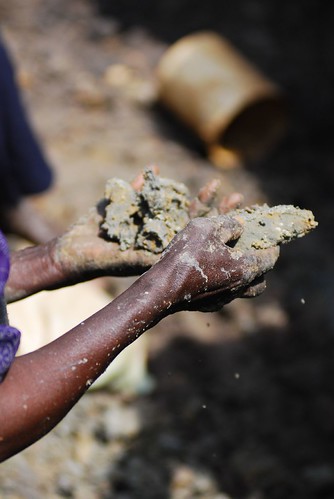


1 comment:
Jon,
This is an excellent photo essay of Robai. I saw her at the market last Thursday. She was cheerful as ever. She helped me pick a nice Luo pot. I apcked the pot carefully this time in the hope that it would make it here safely. It did but sustained some cracks on lip mouth and lip. I will repair it this weekend. Oh well...anyhow, robai rocks.
Post a Comment